BIBM794 - Research Proposal: Customer Retention in New Zealand Telecom
VerifiedAdded on 2023/04/05
|26
|4748
|204
Report
AI Summary
This research proposal investigates customer retention within New Zealand's telecommunication sector, focusing on companies like Vodafone, 2Degrees, and Spark. It includes an organizational context analyzing market share, international benefits, and promotional methods. The literature review explores key factors influencing customer retention, such as service quality, customer satisfaction, switching costs and the impact of relationship marketing. The proposal outlines the research aim, scope, methodology, limitations, ethical implications, cost, and timeline for the project. It emphasizes the challenges faced by telecommunication companies in retaining customers amidst increasing competition and technological advancements, highlighting the importance of integrated communication frameworks and customer-centric strategies. Desklib provides students access to similar research proposals and resources.

Running head: RESEARCH PROPOSAL
Research Proposal
Name of Student-
Student ID-
Assessment and Title-
Academic Supervisor-
Author’s Note-
Research Proposal
Name of Student-
Student ID-
Assessment and Title-
Academic Supervisor-
Author’s Note-
Paraphrase This Document
Need a fresh take? Get an instant paraphrase of this document with our AI Paraphraser
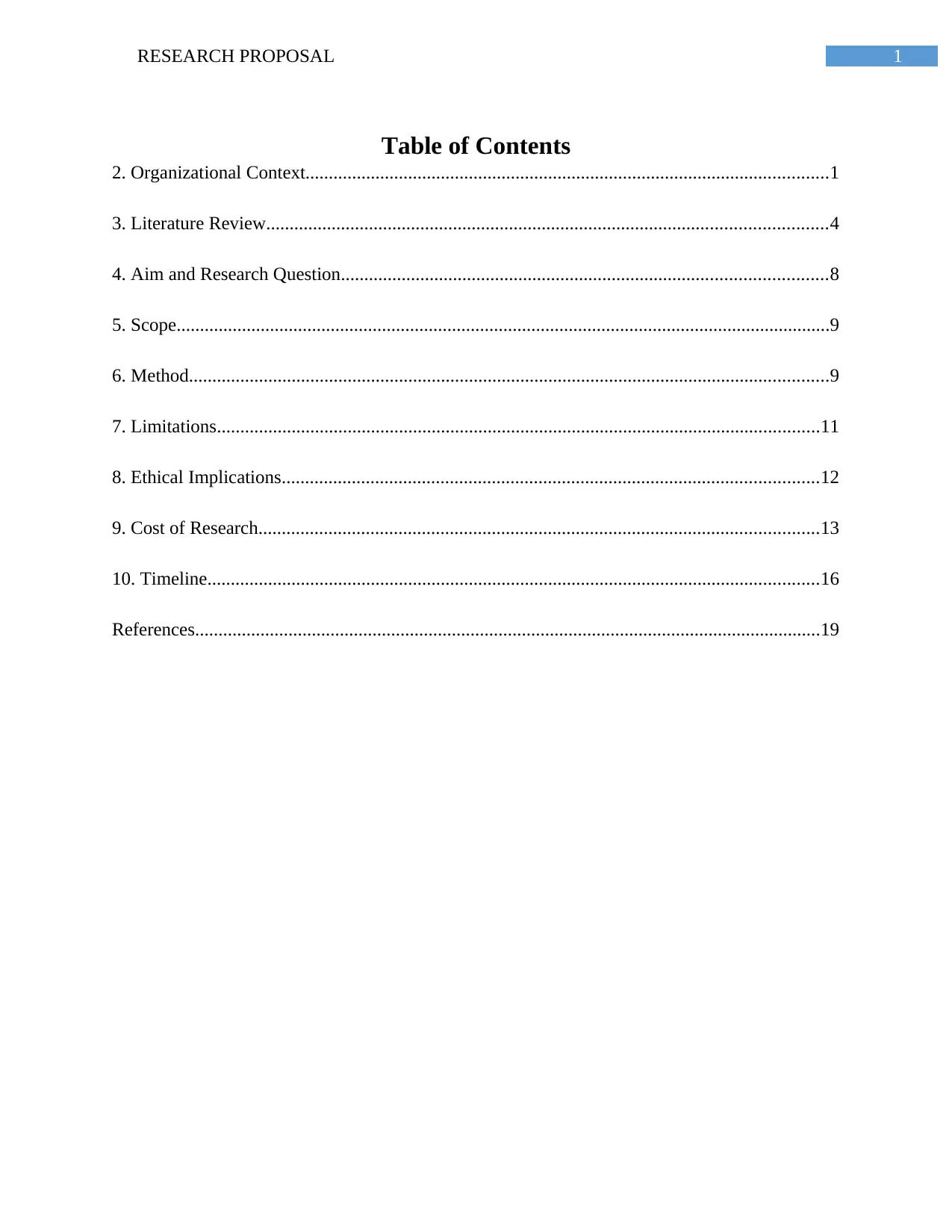
1RESEARCH PROPOSAL
Table of Contents
2. Organizational Context................................................................................................................1
3. Literature Review........................................................................................................................4
4. Aim and Research Question........................................................................................................8
5. Scope............................................................................................................................................9
6. Method.........................................................................................................................................9
7. Limitations.................................................................................................................................11
8. Ethical Implications...................................................................................................................12
9. Cost of Research........................................................................................................................13
10. Timeline...................................................................................................................................16
References......................................................................................................................................19
Table of Contents
2. Organizational Context................................................................................................................1
3. Literature Review........................................................................................................................4
4. Aim and Research Question........................................................................................................8
5. Scope............................................................................................................................................9
6. Method.........................................................................................................................................9
7. Limitations.................................................................................................................................11
8. Ethical Implications...................................................................................................................12
9. Cost of Research........................................................................................................................13
10. Timeline...................................................................................................................................16
References......................................................................................................................................19
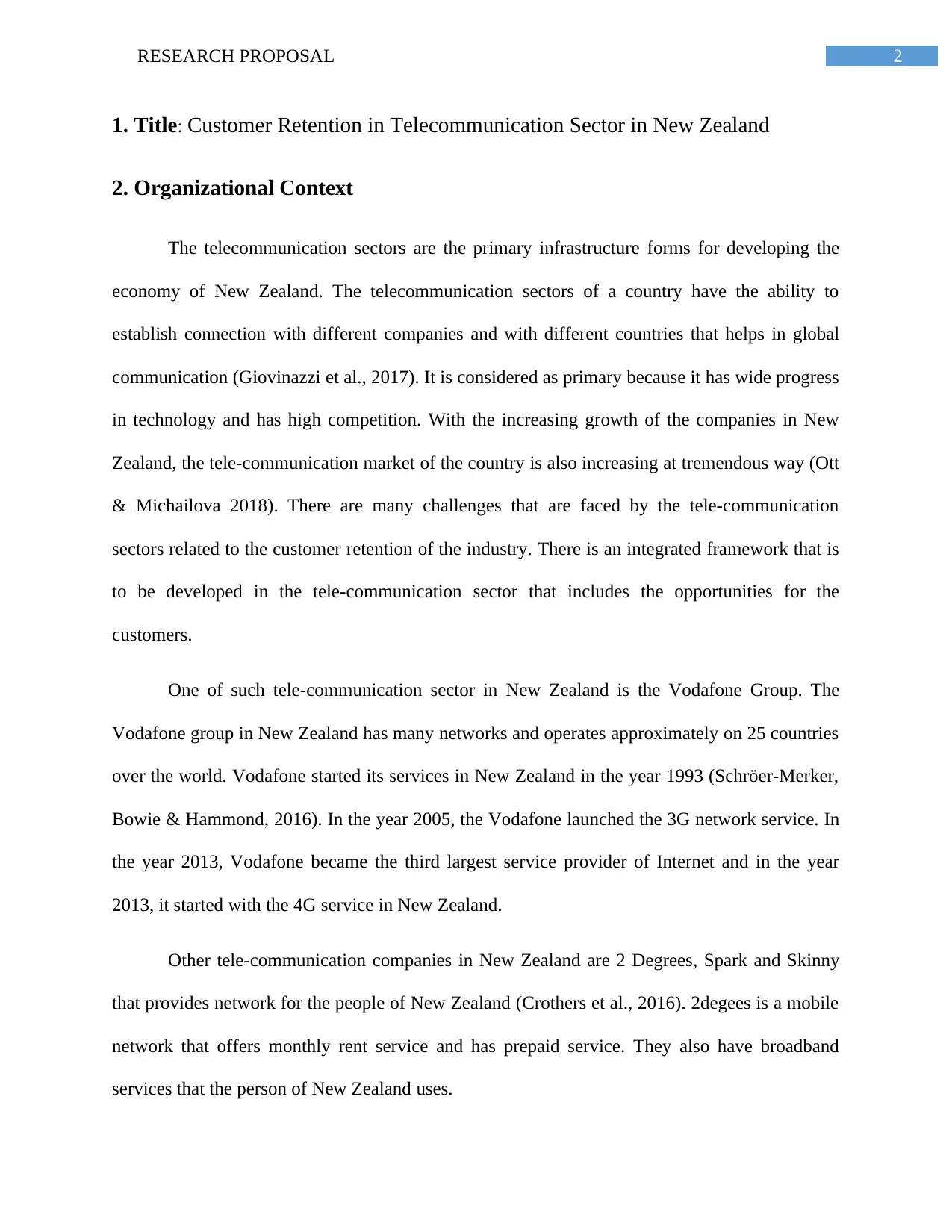
2RESEARCH PROPOSAL
1. Title: Customer Retention in Telecommunication Sector in New Zealand
2. Organizational Context
The telecommunication sectors are the primary infrastructure forms for developing the
economy of New Zealand. The telecommunication sectors of a country have the ability to
establish connection with different companies and with different countries that helps in global
communication (Giovinazzi et al., 2017). It is considered as primary because it has wide progress
in technology and has high competition. With the increasing growth of the companies in New
Zealand, the tele-communication market of the country is also increasing at tremendous way (Ott
& Michailova 2018). There are many challenges that are faced by the tele-communication
sectors related to the customer retention of the industry. There is an integrated framework that is
to be developed in the tele-communication sector that includes the opportunities for the
customers.
One of such tele-communication sector in New Zealand is the Vodafone Group. The
Vodafone group in New Zealand has many networks and operates approximately on 25 countries
over the world. Vodafone started its services in New Zealand in the year 1993 (Schröer-Merker,
Bowie & Hammond, 2016). In the year 2005, the Vodafone launched the 3G network service. In
the year 2013, Vodafone became the third largest service provider of Internet and in the year
2013, it started with the 4G service in New Zealand.
Other tele-communication companies in New Zealand are 2 Degrees, Spark and Skinny
that provides network for the people of New Zealand (Crothers et al., 2016). 2degees is a mobile
network that offers monthly rent service and has prepaid service. They also have broadband
services that the person of New Zealand uses.
1. Title: Customer Retention in Telecommunication Sector in New Zealand
2. Organizational Context
The telecommunication sectors are the primary infrastructure forms for developing the
economy of New Zealand. The telecommunication sectors of a country have the ability to
establish connection with different companies and with different countries that helps in global
communication (Giovinazzi et al., 2017). It is considered as primary because it has wide progress
in technology and has high competition. With the increasing growth of the companies in New
Zealand, the tele-communication market of the country is also increasing at tremendous way (Ott
& Michailova 2018). There are many challenges that are faced by the tele-communication
sectors related to the customer retention of the industry. There is an integrated framework that is
to be developed in the tele-communication sector that includes the opportunities for the
customers.
One of such tele-communication sector in New Zealand is the Vodafone Group. The
Vodafone group in New Zealand has many networks and operates approximately on 25 countries
over the world. Vodafone started its services in New Zealand in the year 1993 (Schröer-Merker,
Bowie & Hammond, 2016). In the year 2005, the Vodafone launched the 3G network service. In
the year 2013, Vodafone became the third largest service provider of Internet and in the year
2013, it started with the 4G service in New Zealand.
Other tele-communication companies in New Zealand are 2 Degrees, Spark and Skinny
that provides network for the people of New Zealand (Crothers et al., 2016). 2degees is a mobile
network that offers monthly rent service and has prepaid service. They also have broadband
services that the person of New Zealand uses.
⊘ This is a preview!⊘
Do you want full access?
Subscribe today to unlock all pages.

Trusted by 1+ million students worldwide
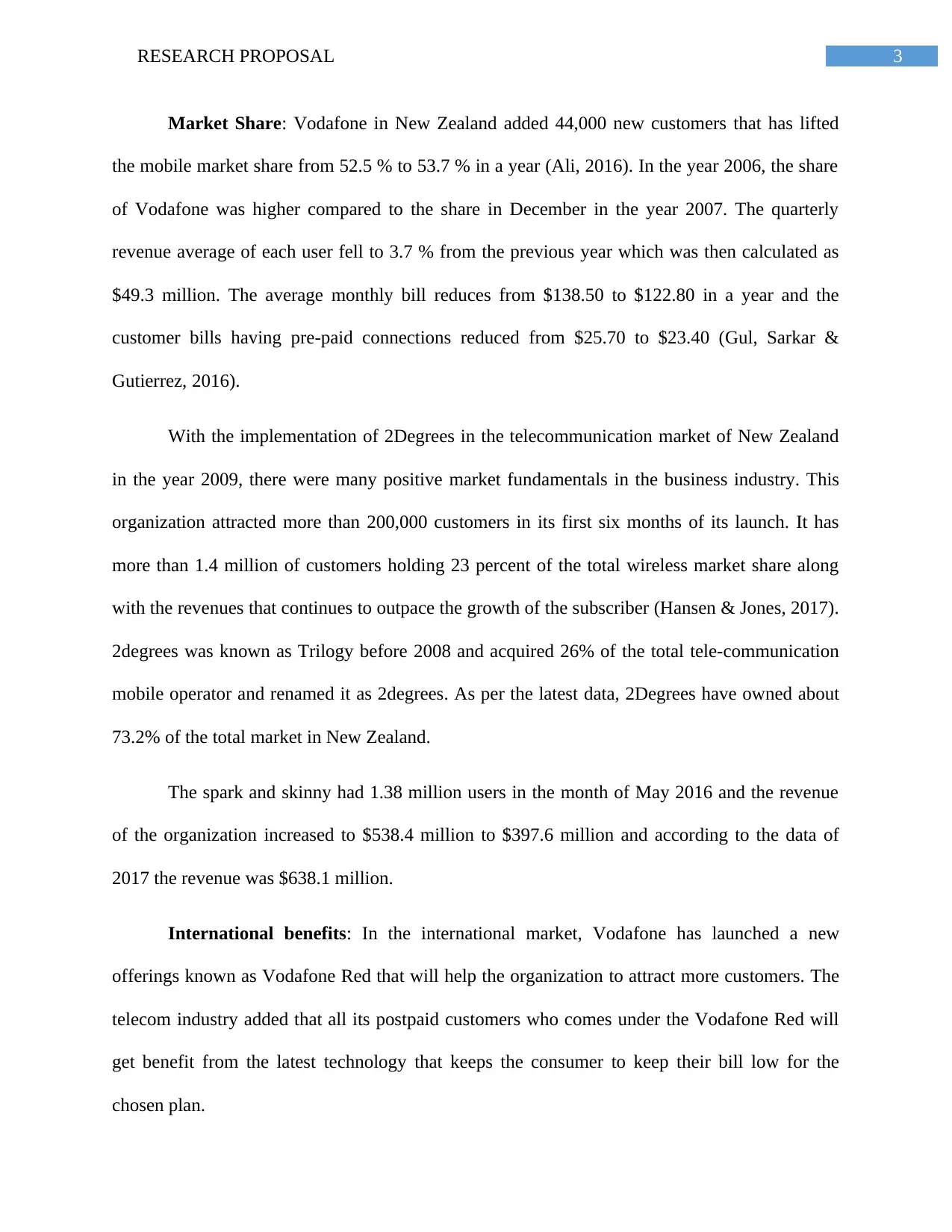
3RESEARCH PROPOSAL
Market Share: Vodafone in New Zealand added 44,000 new customers that has lifted
the mobile market share from 52.5 % to 53.7 % in a year (Ali, 2016). In the year 2006, the share
of Vodafone was higher compared to the share in December in the year 2007. The quarterly
revenue average of each user fell to 3.7 % from the previous year which was then calculated as
$49.3 million. The average monthly bill reduces from $138.50 to $122.80 in a year and the
customer bills having pre-paid connections reduced from $25.70 to $23.40 (Gul, Sarkar &
Gutierrez, 2016).
With the implementation of 2Degrees in the telecommunication market of New Zealand
in the year 2009, there were many positive market fundamentals in the business industry. This
organization attracted more than 200,000 customers in its first six months of its launch. It has
more than 1.4 million of customers holding 23 percent of the total wireless market share along
with the revenues that continues to outpace the growth of the subscriber (Hansen & Jones, 2017).
2degrees was known as Trilogy before 2008 and acquired 26% of the total tele-communication
mobile operator and renamed it as 2degrees. As per the latest data, 2Degrees have owned about
73.2% of the total market in New Zealand.
The spark and skinny had 1.38 million users in the month of May 2016 and the revenue
of the organization increased to $538.4 million to $397.6 million and according to the data of
2017 the revenue was $638.1 million.
International benefits: In the international market, Vodafone has launched a new
offerings known as Vodafone Red that will help the organization to attract more customers. The
telecom industry added that all its postpaid customers who comes under the Vodafone Red will
get benefit from the latest technology that keeps the consumer to keep their bill low for the
chosen plan.
Market Share: Vodafone in New Zealand added 44,000 new customers that has lifted
the mobile market share from 52.5 % to 53.7 % in a year (Ali, 2016). In the year 2006, the share
of Vodafone was higher compared to the share in December in the year 2007. The quarterly
revenue average of each user fell to 3.7 % from the previous year which was then calculated as
$49.3 million. The average monthly bill reduces from $138.50 to $122.80 in a year and the
customer bills having pre-paid connections reduced from $25.70 to $23.40 (Gul, Sarkar &
Gutierrez, 2016).
With the implementation of 2Degrees in the telecommunication market of New Zealand
in the year 2009, there were many positive market fundamentals in the business industry. This
organization attracted more than 200,000 customers in its first six months of its launch. It has
more than 1.4 million of customers holding 23 percent of the total wireless market share along
with the revenues that continues to outpace the growth of the subscriber (Hansen & Jones, 2017).
2degrees was known as Trilogy before 2008 and acquired 26% of the total tele-communication
mobile operator and renamed it as 2degrees. As per the latest data, 2Degrees have owned about
73.2% of the total market in New Zealand.
The spark and skinny had 1.38 million users in the month of May 2016 and the revenue
of the organization increased to $538.4 million to $397.6 million and according to the data of
2017 the revenue was $638.1 million.
International benefits: In the international market, Vodafone has launched a new
offerings known as Vodafone Red that will help the organization to attract more customers. The
telecom industry added that all its postpaid customers who comes under the Vodafone Red will
get benefit from the latest technology that keeps the consumer to keep their bill low for the
chosen plan.
Paraphrase This Document
Need a fresh take? Get an instant paraphrase of this document with our AI Paraphraser
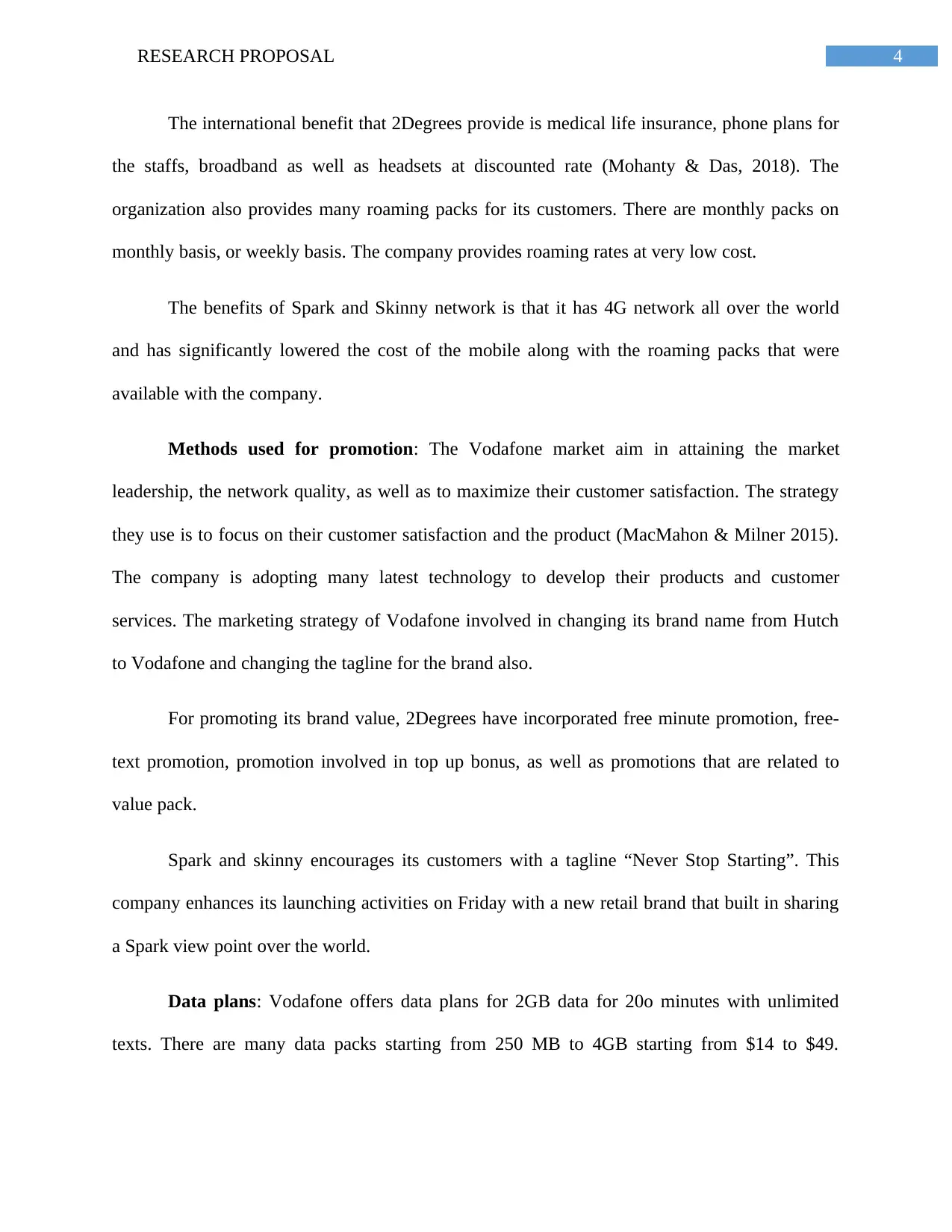
4RESEARCH PROPOSAL
The international benefit that 2Degrees provide is medical life insurance, phone plans for
the staffs, broadband as well as headsets at discounted rate (Mohanty & Das, 2018). The
organization also provides many roaming packs for its customers. There are monthly packs on
monthly basis, or weekly basis. The company provides roaming rates at very low cost.
The benefits of Spark and Skinny network is that it has 4G network all over the world
and has significantly lowered the cost of the mobile along with the roaming packs that were
available with the company.
Methods used for promotion: The Vodafone market aim in attaining the market
leadership, the network quality, as well as to maximize their customer satisfaction. The strategy
they use is to focus on their customer satisfaction and the product (MacMahon & Milner 2015).
The company is adopting many latest technology to develop their products and customer
services. The marketing strategy of Vodafone involved in changing its brand name from Hutch
to Vodafone and changing the tagline for the brand also.
For promoting its brand value, 2Degrees have incorporated free minute promotion, free-
text promotion, promotion involved in top up bonus, as well as promotions that are related to
value pack.
Spark and skinny encourages its customers with a tagline “Never Stop Starting”. This
company enhances its launching activities on Friday with a new retail brand that built in sharing
a Spark view point over the world.
Data plans: Vodafone offers data plans for 2GB data for 20o minutes with unlimited
texts. There are many data packs starting from 250 MB to 4GB starting from $14 to $49.
The international benefit that 2Degrees provide is medical life insurance, phone plans for
the staffs, broadband as well as headsets at discounted rate (Mohanty & Das, 2018). The
organization also provides many roaming packs for its customers. There are monthly packs on
monthly basis, or weekly basis. The company provides roaming rates at very low cost.
The benefits of Spark and Skinny network is that it has 4G network all over the world
and has significantly lowered the cost of the mobile along with the roaming packs that were
available with the company.
Methods used for promotion: The Vodafone market aim in attaining the market
leadership, the network quality, as well as to maximize their customer satisfaction. The strategy
they use is to focus on their customer satisfaction and the product (MacMahon & Milner 2015).
The company is adopting many latest technology to develop their products and customer
services. The marketing strategy of Vodafone involved in changing its brand name from Hutch
to Vodafone and changing the tagline for the brand also.
For promoting its brand value, 2Degrees have incorporated free minute promotion, free-
text promotion, promotion involved in top up bonus, as well as promotions that are related to
value pack.
Spark and skinny encourages its customers with a tagline “Never Stop Starting”. This
company enhances its launching activities on Friday with a new retail brand that built in sharing
a Spark view point over the world.
Data plans: Vodafone offers data plans for 2GB data for 20o minutes with unlimited
texts. There are many data packs starting from 250 MB to 4GB starting from $14 to $49.
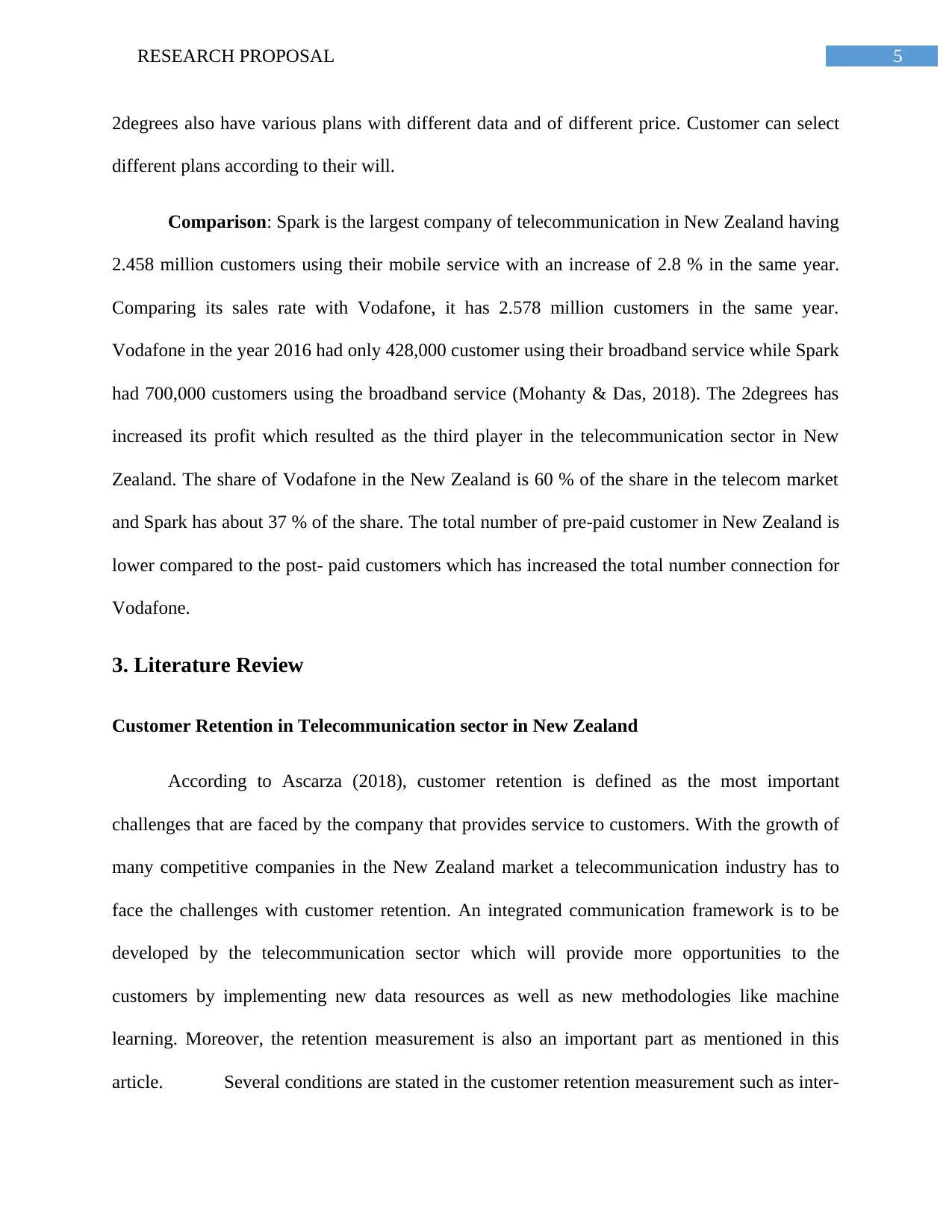
5RESEARCH PROPOSAL
2degrees also have various plans with different data and of different price. Customer can select
different plans according to their will.
Comparison: Spark is the largest company of telecommunication in New Zealand having
2.458 million customers using their mobile service with an increase of 2.8 % in the same year.
Comparing its sales rate with Vodafone, it has 2.578 million customers in the same year.
Vodafone in the year 2016 had only 428,000 customer using their broadband service while Spark
had 700,000 customers using the broadband service (Mohanty & Das, 2018). The 2degrees has
increased its profit which resulted as the third player in the telecommunication sector in New
Zealand. The share of Vodafone in the New Zealand is 60 % of the share in the telecom market
and Spark has about 37 % of the share. The total number of pre-paid customer in New Zealand is
lower compared to the post- paid customers which has increased the total number connection for
Vodafone.
3. Literature Review
Customer Retention in Telecommunication sector in New Zealand
According to Ascarza (2018), customer retention is defined as the most important
challenges that are faced by the company that provides service to customers. With the growth of
many competitive companies in the New Zealand market a telecommunication industry has to
face the challenges with customer retention. An integrated communication framework is to be
developed by the telecommunication sector which will provide more opportunities to the
customers by implementing new data resources as well as new methodologies like machine
learning. Moreover, the retention measurement is also an important part as mentioned in this
article. Several conditions are stated in the customer retention measurement such as inter-
2degrees also have various plans with different data and of different price. Customer can select
different plans according to their will.
Comparison: Spark is the largest company of telecommunication in New Zealand having
2.458 million customers using their mobile service with an increase of 2.8 % in the same year.
Comparing its sales rate with Vodafone, it has 2.578 million customers in the same year.
Vodafone in the year 2016 had only 428,000 customer using their broadband service while Spark
had 700,000 customers using the broadband service (Mohanty & Das, 2018). The 2degrees has
increased its profit which resulted as the third player in the telecommunication sector in New
Zealand. The share of Vodafone in the New Zealand is 60 % of the share in the telecom market
and Spark has about 37 % of the share. The total number of pre-paid customer in New Zealand is
lower compared to the post- paid customers which has increased the total number connection for
Vodafone.
3. Literature Review
Customer Retention in Telecommunication sector in New Zealand
According to Ascarza (2018), customer retention is defined as the most important
challenges that are faced by the company that provides service to customers. With the growth of
many competitive companies in the New Zealand market a telecommunication industry has to
face the challenges with customer retention. An integrated communication framework is to be
developed by the telecommunication sector which will provide more opportunities to the
customers by implementing new data resources as well as new methodologies like machine
learning. Moreover, the retention measurement is also an important part as mentioned in this
article. Several conditions are stated in the customer retention measurement such as inter-
⊘ This is a preview!⊘
Do you want full access?
Subscribe today to unlock all pages.

Trusted by 1+ million students worldwide
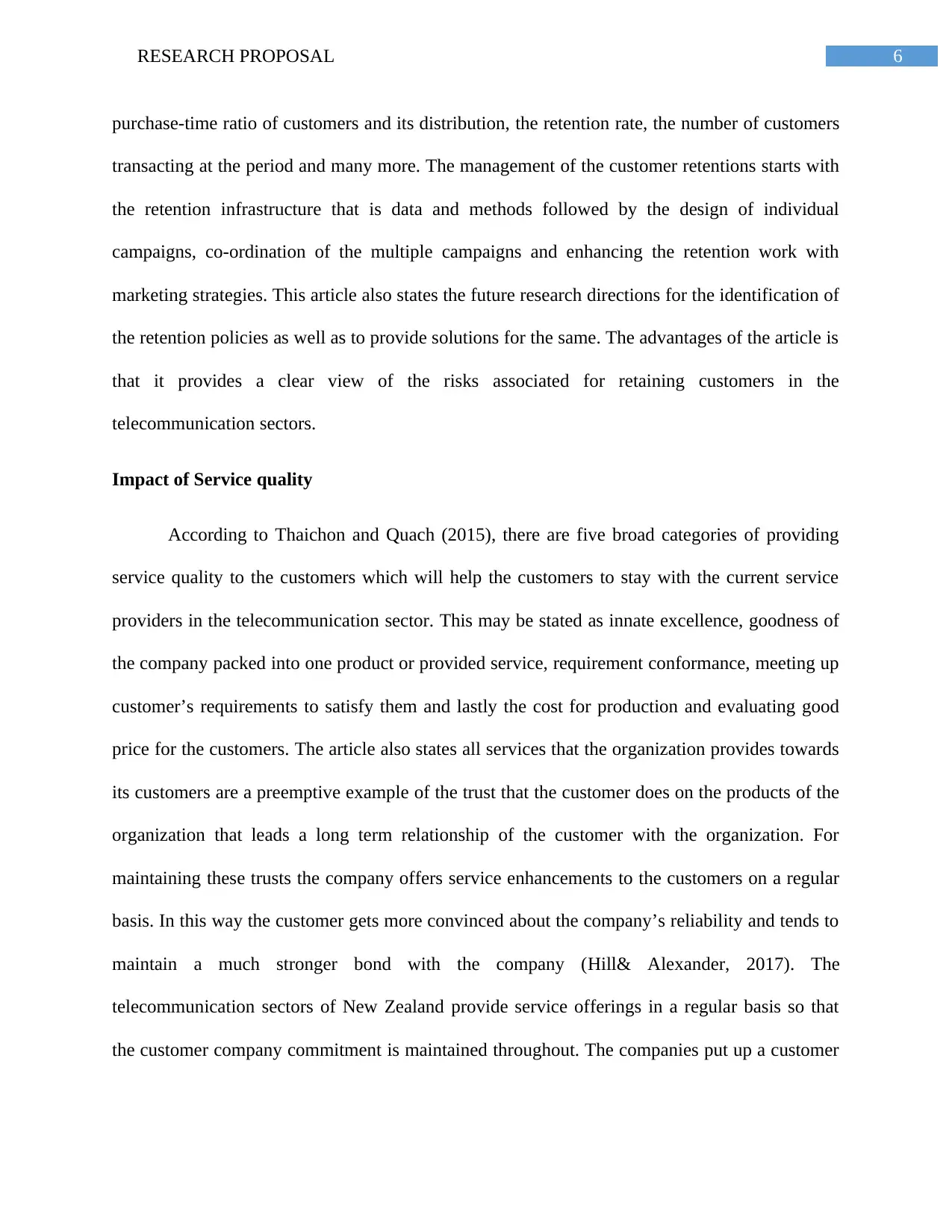
6RESEARCH PROPOSAL
purchase-time ratio of customers and its distribution, the retention rate, the number of customers
transacting at the period and many more. The management of the customer retentions starts with
the retention infrastructure that is data and methods followed by the design of individual
campaigns, co-ordination of the multiple campaigns and enhancing the retention work with
marketing strategies. This article also states the future research directions for the identification of
the retention policies as well as to provide solutions for the same. The advantages of the article is
that it provides a clear view of the risks associated for retaining customers in the
telecommunication sectors.
Impact of Service quality
According to Thaichon and Quach (2015), there are five broad categories of providing
service quality to the customers which will help the customers to stay with the current service
providers in the telecommunication sector. This may be stated as innate excellence, goodness of
the company packed into one product or provided service, requirement conformance, meeting up
customer’s requirements to satisfy them and lastly the cost for production and evaluating good
price for the customers. The article also states all services that the organization provides towards
its customers are a preemptive example of the trust that the customer does on the products of the
organization that leads a long term relationship of the customer with the organization. For
maintaining these trusts the company offers service enhancements to the customers on a regular
basis. In this way the customer gets more convinced about the company’s reliability and tends to
maintain a much stronger bond with the company (Hill& Alexander, 2017). The
telecommunication sectors of New Zealand provide service offerings in a regular basis so that
the customer company commitment is maintained throughout. The companies put up a customer
purchase-time ratio of customers and its distribution, the retention rate, the number of customers
transacting at the period and many more. The management of the customer retentions starts with
the retention infrastructure that is data and methods followed by the design of individual
campaigns, co-ordination of the multiple campaigns and enhancing the retention work with
marketing strategies. This article also states the future research directions for the identification of
the retention policies as well as to provide solutions for the same. The advantages of the article is
that it provides a clear view of the risks associated for retaining customers in the
telecommunication sectors.
Impact of Service quality
According to Thaichon and Quach (2015), there are five broad categories of providing
service quality to the customers which will help the customers to stay with the current service
providers in the telecommunication sector. This may be stated as innate excellence, goodness of
the company packed into one product or provided service, requirement conformance, meeting up
customer’s requirements to satisfy them and lastly the cost for production and evaluating good
price for the customers. The article also states all services that the organization provides towards
its customers are a preemptive example of the trust that the customer does on the products of the
organization that leads a long term relationship of the customer with the organization. For
maintaining these trusts the company offers service enhancements to the customers on a regular
basis. In this way the customer gets more convinced about the company’s reliability and tends to
maintain a much stronger bond with the company (Hill& Alexander, 2017). The
telecommunication sectors of New Zealand provide service offerings in a regular basis so that
the customer company commitment is maintained throughout. The companies put up a customer
Paraphrase This Document
Need a fresh take? Get an instant paraphrase of this document with our AI Paraphraser
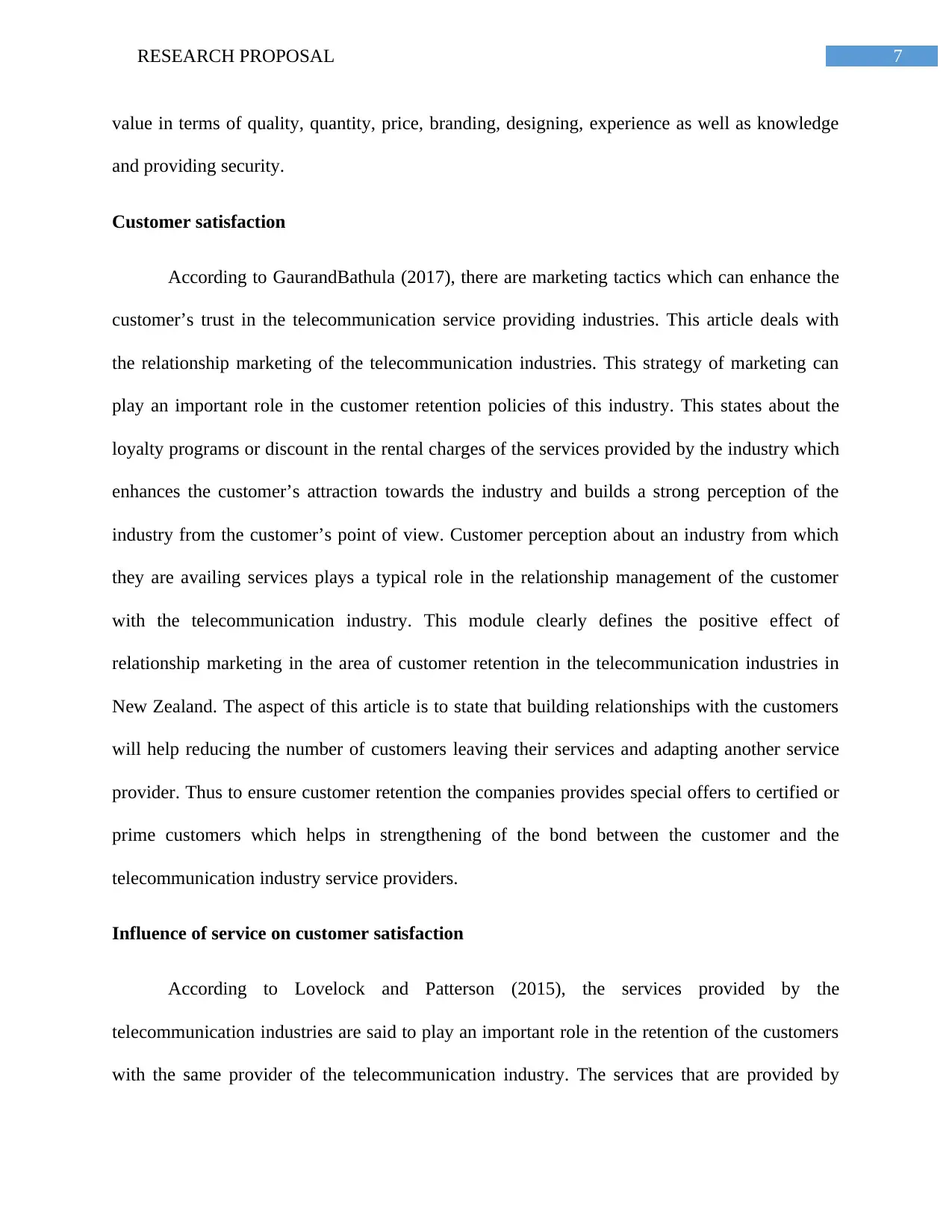
7RESEARCH PROPOSAL
value in terms of quality, quantity, price, branding, designing, experience as well as knowledge
and providing security.
Customer satisfaction
According to GaurandBathula (2017), there are marketing tactics which can enhance the
customer’s trust in the telecommunication service providing industries. This article deals with
the relationship marketing of the telecommunication industries. This strategy of marketing can
play an important role in the customer retention policies of this industry. This states about the
loyalty programs or discount in the rental charges of the services provided by the industry which
enhances the customer’s attraction towards the industry and builds a strong perception of the
industry from the customer’s point of view. Customer perception about an industry from which
they are availing services plays a typical role in the relationship management of the customer
with the telecommunication industry. This module clearly defines the positive effect of
relationship marketing in the area of customer retention in the telecommunication industries in
New Zealand. The aspect of this article is to state that building relationships with the customers
will help reducing the number of customers leaving their services and adapting another service
provider. Thus to ensure customer retention the companies provides special offers to certified or
prime customers which helps in strengthening of the bond between the customer and the
telecommunication industry service providers.
Influence of service on customer satisfaction
According to Lovelock and Patterson (2015), the services provided by the
telecommunication industries are said to play an important role in the retention of the customers
with the same provider of the telecommunication industry. The services that are provided by
value in terms of quality, quantity, price, branding, designing, experience as well as knowledge
and providing security.
Customer satisfaction
According to GaurandBathula (2017), there are marketing tactics which can enhance the
customer’s trust in the telecommunication service providing industries. This article deals with
the relationship marketing of the telecommunication industries. This strategy of marketing can
play an important role in the customer retention policies of this industry. This states about the
loyalty programs or discount in the rental charges of the services provided by the industry which
enhances the customer’s attraction towards the industry and builds a strong perception of the
industry from the customer’s point of view. Customer perception about an industry from which
they are availing services plays a typical role in the relationship management of the customer
with the telecommunication industry. This module clearly defines the positive effect of
relationship marketing in the area of customer retention in the telecommunication industries in
New Zealand. The aspect of this article is to state that building relationships with the customers
will help reducing the number of customers leaving their services and adapting another service
provider. Thus to ensure customer retention the companies provides special offers to certified or
prime customers which helps in strengthening of the bond between the customer and the
telecommunication industry service providers.
Influence of service on customer satisfaction
According to Lovelock and Patterson (2015), the services provided by the
telecommunication industries are said to play an important role in the retention of the customers
with the same provider of the telecommunication industry. The services that are provided by
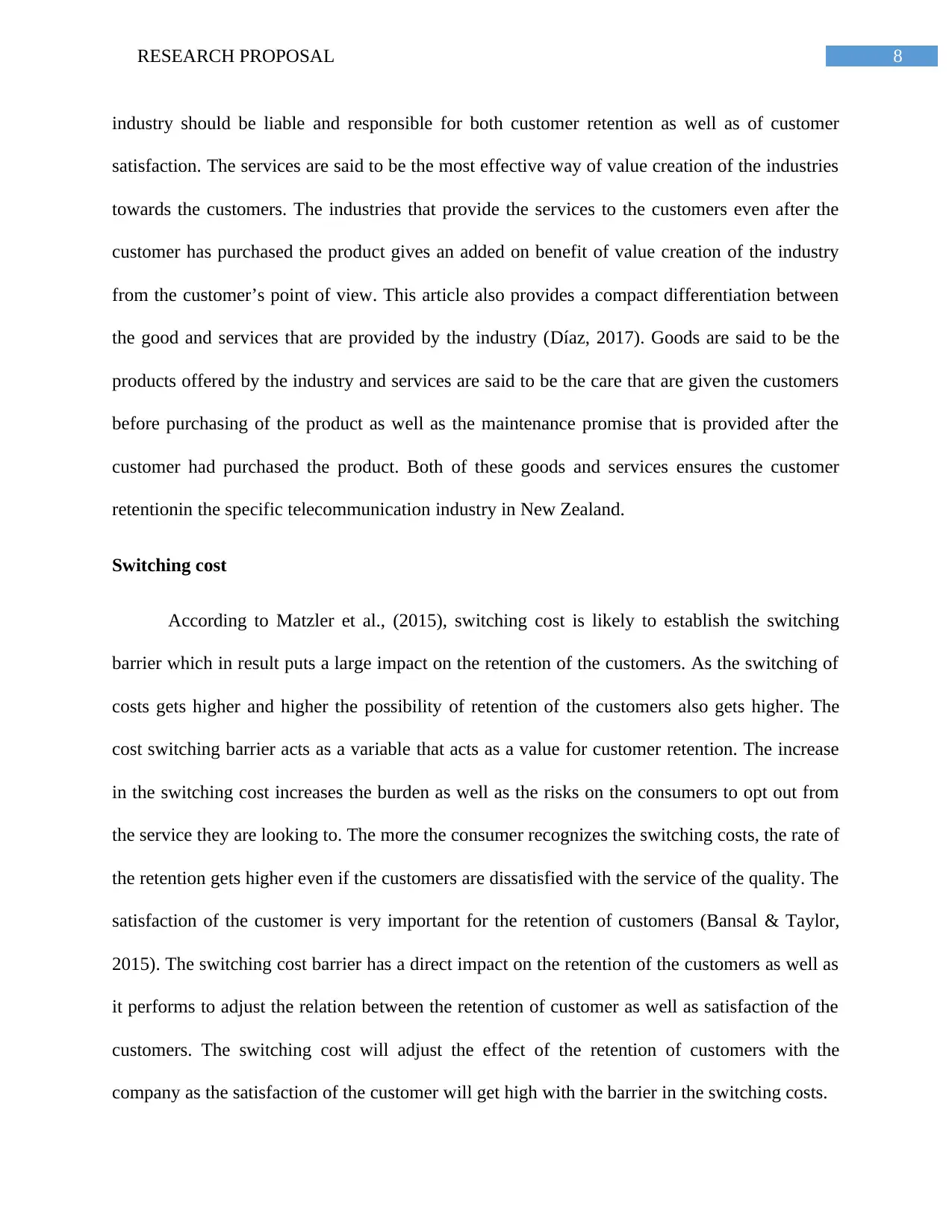
8RESEARCH PROPOSAL
industry should be liable and responsible for both customer retention as well as of customer
satisfaction. The services are said to be the most effective way of value creation of the industries
towards the customers. The industries that provide the services to the customers even after the
customer has purchased the product gives an added on benefit of value creation of the industry
from the customer’s point of view. This article also provides a compact differentiation between
the good and services that are provided by the industry (Díaz, 2017). Goods are said to be the
products offered by the industry and services are said to be the care that are given the customers
before purchasing of the product as well as the maintenance promise that is provided after the
customer had purchased the product. Both of these goods and services ensures the customer
retentionin the specific telecommunication industry in New Zealand.
Switching cost
According to Matzler et al., (2015), switching cost is likely to establish the switching
barrier which in result puts a large impact on the retention of the customers. As the switching of
costs gets higher and higher the possibility of retention of the customers also gets higher. The
cost switching barrier acts as a variable that acts as a value for customer retention. The increase
in the switching cost increases the burden as well as the risks on the consumers to opt out from
the service they are looking to. The more the consumer recognizes the switching costs, the rate of
the retention gets higher even if the customers are dissatisfied with the service of the quality. The
satisfaction of the customer is very important for the retention of customers (Bansal & Taylor,
2015). The switching cost barrier has a direct impact on the retention of the customers as well as
it performs to adjust the relation between the retention of customer as well as satisfaction of the
customers. The switching cost will adjust the effect of the retention of customers with the
company as the satisfaction of the customer will get high with the barrier in the switching costs.
industry should be liable and responsible for both customer retention as well as of customer
satisfaction. The services are said to be the most effective way of value creation of the industries
towards the customers. The industries that provide the services to the customers even after the
customer has purchased the product gives an added on benefit of value creation of the industry
from the customer’s point of view. This article also provides a compact differentiation between
the good and services that are provided by the industry (Díaz, 2017). Goods are said to be the
products offered by the industry and services are said to be the care that are given the customers
before purchasing of the product as well as the maintenance promise that is provided after the
customer had purchased the product. Both of these goods and services ensures the customer
retentionin the specific telecommunication industry in New Zealand.
Switching cost
According to Matzler et al., (2015), switching cost is likely to establish the switching
barrier which in result puts a large impact on the retention of the customers. As the switching of
costs gets higher and higher the possibility of retention of the customers also gets higher. The
cost switching barrier acts as a variable that acts as a value for customer retention. The increase
in the switching cost increases the burden as well as the risks on the consumers to opt out from
the service they are looking to. The more the consumer recognizes the switching costs, the rate of
the retention gets higher even if the customers are dissatisfied with the service of the quality. The
satisfaction of the customer is very important for the retention of customers (Bansal & Taylor,
2015). The switching cost barrier has a direct impact on the retention of the customers as well as
it performs to adjust the relation between the retention of customer as well as satisfaction of the
customers. The switching cost will adjust the effect of the retention of customers with the
company as the satisfaction of the customer will get high with the barrier in the switching costs.
⊘ This is a preview!⊘
Do you want full access?
Subscribe today to unlock all pages.

Trusted by 1+ million students worldwide
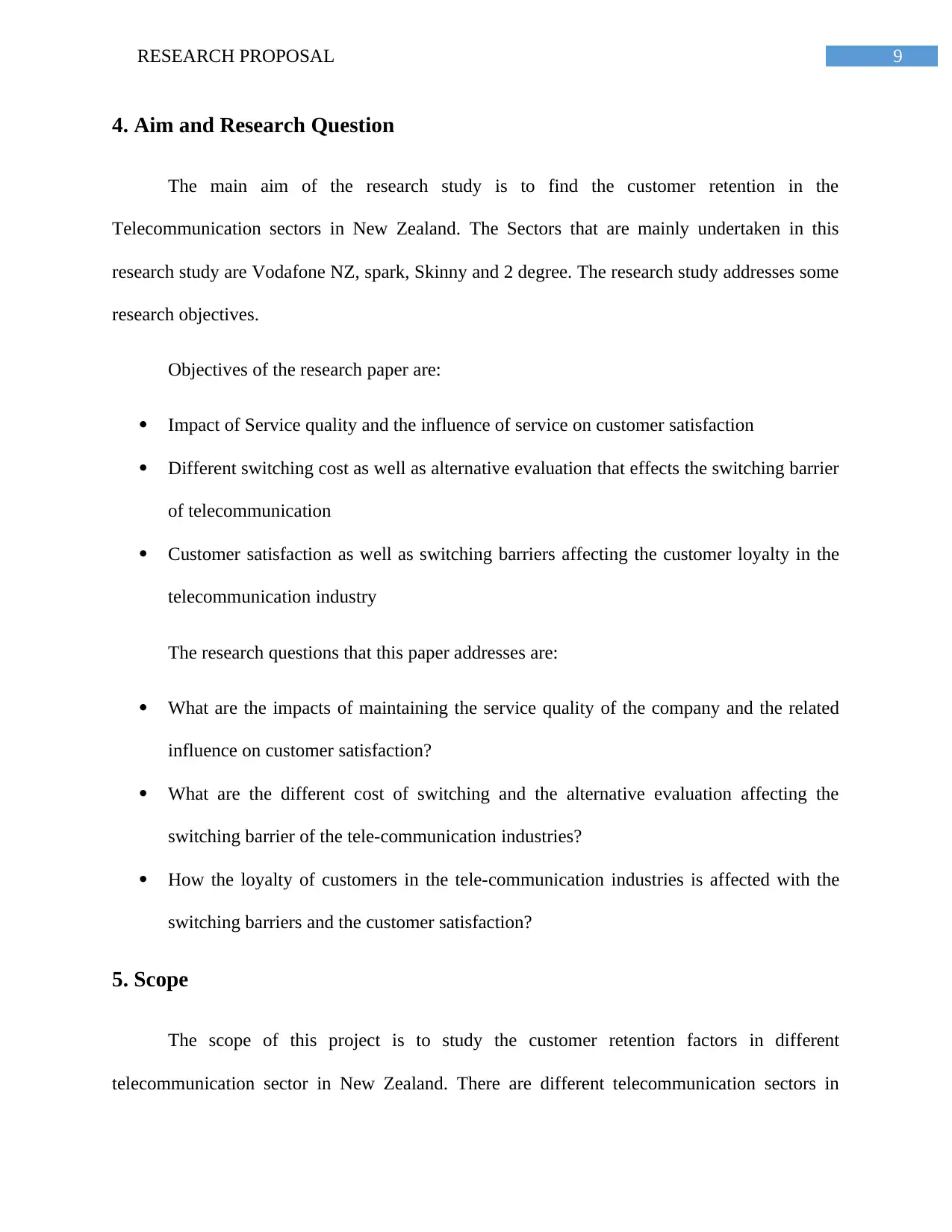
9RESEARCH PROPOSAL
4. Aim and Research Question
The main aim of the research study is to find the customer retention in the
Telecommunication sectors in New Zealand. The Sectors that are mainly undertaken in this
research study are Vodafone NZ, spark, Skinny and 2 degree. The research study addresses some
research objectives.
Objectives of the research paper are:
Impact of Service quality and the influence of service on customer satisfaction
Different switching cost as well as alternative evaluation that effects the switching barrier
of telecommunication
Customer satisfaction as well as switching barriers affecting the customer loyalty in the
telecommunication industry
The research questions that this paper addresses are:
What are the impacts of maintaining the service quality of the company and the related
influence on customer satisfaction?
What are the different cost of switching and the alternative evaluation affecting the
switching barrier of the tele-communication industries?
How the loyalty of customers in the tele-communication industries is affected with the
switching barriers and the customer satisfaction?
5. Scope
The scope of this project is to study the customer retention factors in different
telecommunication sector in New Zealand. There are different telecommunication sectors in
4. Aim and Research Question
The main aim of the research study is to find the customer retention in the
Telecommunication sectors in New Zealand. The Sectors that are mainly undertaken in this
research study are Vodafone NZ, spark, Skinny and 2 degree. The research study addresses some
research objectives.
Objectives of the research paper are:
Impact of Service quality and the influence of service on customer satisfaction
Different switching cost as well as alternative evaluation that effects the switching barrier
of telecommunication
Customer satisfaction as well as switching barriers affecting the customer loyalty in the
telecommunication industry
The research questions that this paper addresses are:
What are the impacts of maintaining the service quality of the company and the related
influence on customer satisfaction?
What are the different cost of switching and the alternative evaluation affecting the
switching barrier of the tele-communication industries?
How the loyalty of customers in the tele-communication industries is affected with the
switching barriers and the customer satisfaction?
5. Scope
The scope of this project is to study the customer retention factors in different
telecommunication sector in New Zealand. There are different telecommunication sectors in
Paraphrase This Document
Need a fresh take? Get an instant paraphrase of this document with our AI Paraphraser
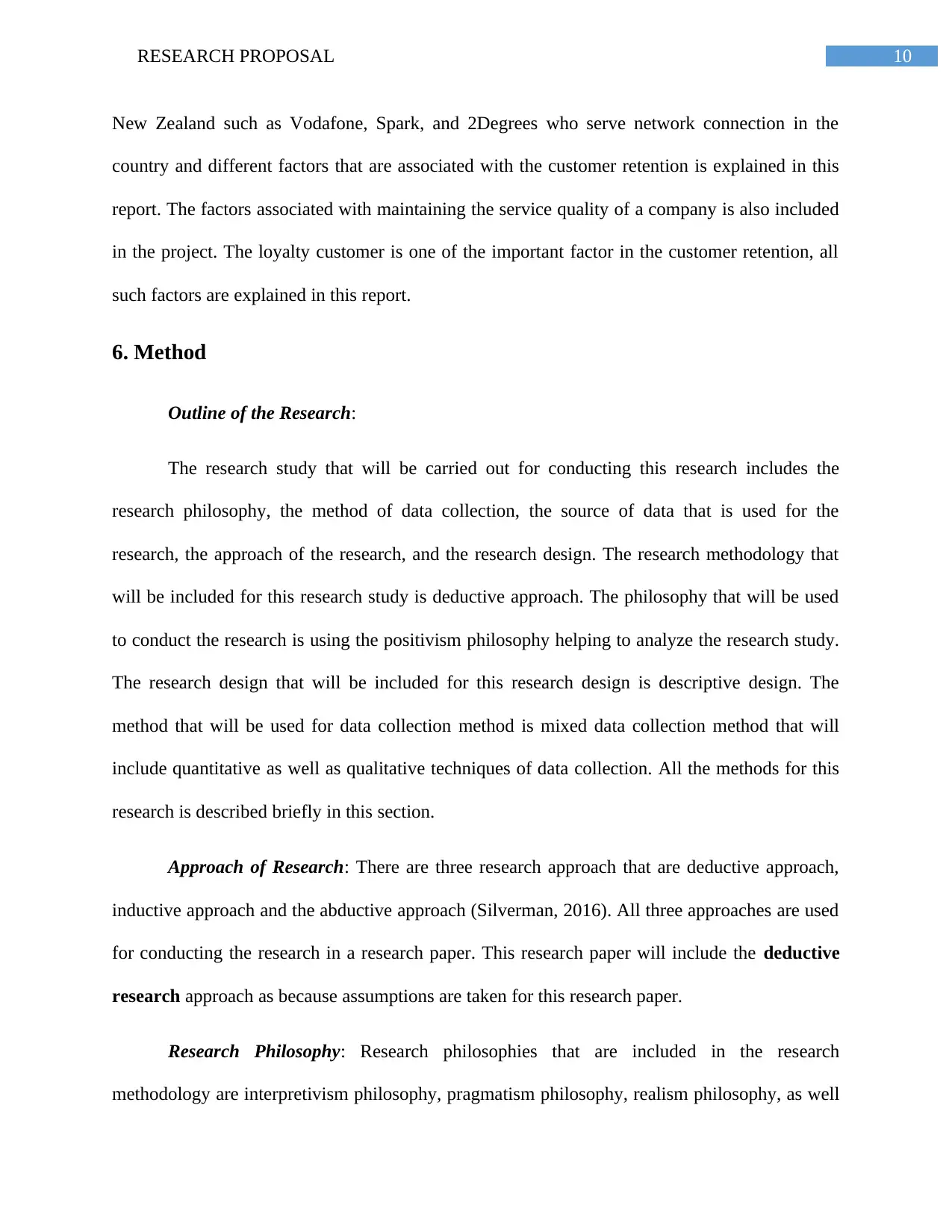
10RESEARCH PROPOSAL
New Zealand such as Vodafone, Spark, and 2Degrees who serve network connection in the
country and different factors that are associated with the customer retention is explained in this
report. The factors associated with maintaining the service quality of a company is also included
in the project. The loyalty customer is one of the important factor in the customer retention, all
such factors are explained in this report.
6. Method
Outline of the Research:
The research study that will be carried out for conducting this research includes the
research philosophy, the method of data collection, the source of data that is used for the
research, the approach of the research, and the research design. The research methodology that
will be included for this research study is deductive approach. The philosophy that will be used
to conduct the research is using the positivism philosophy helping to analyze the research study.
The research design that will be included for this research design is descriptive design. The
method that will be used for data collection method is mixed data collection method that will
include quantitative as well as qualitative techniques of data collection. All the methods for this
research is described briefly in this section.
Approach of Research: There are three research approach that are deductive approach,
inductive approach and the abductive approach (Silverman, 2016). All three approaches are used
for conducting the research in a research paper. This research paper will include the deductive
research approach as because assumptions are taken for this research paper.
Research Philosophy: Research philosophies that are included in the research
methodology are interpretivism philosophy, pragmatism philosophy, realism philosophy, as well
New Zealand such as Vodafone, Spark, and 2Degrees who serve network connection in the
country and different factors that are associated with the customer retention is explained in this
report. The factors associated with maintaining the service quality of a company is also included
in the project. The loyalty customer is one of the important factor in the customer retention, all
such factors are explained in this report.
6. Method
Outline of the Research:
The research study that will be carried out for conducting this research includes the
research philosophy, the method of data collection, the source of data that is used for the
research, the approach of the research, and the research design. The research methodology that
will be included for this research study is deductive approach. The philosophy that will be used
to conduct the research is using the positivism philosophy helping to analyze the research study.
The research design that will be included for this research design is descriptive design. The
method that will be used for data collection method is mixed data collection method that will
include quantitative as well as qualitative techniques of data collection. All the methods for this
research is described briefly in this section.
Approach of Research: There are three research approach that are deductive approach,
inductive approach and the abductive approach (Silverman, 2016). All three approaches are used
for conducting the research in a research paper. This research paper will include the deductive
research approach as because assumptions are taken for this research paper.
Research Philosophy: Research philosophies that are included in the research
methodology are interpretivism philosophy, pragmatism philosophy, realism philosophy, as well
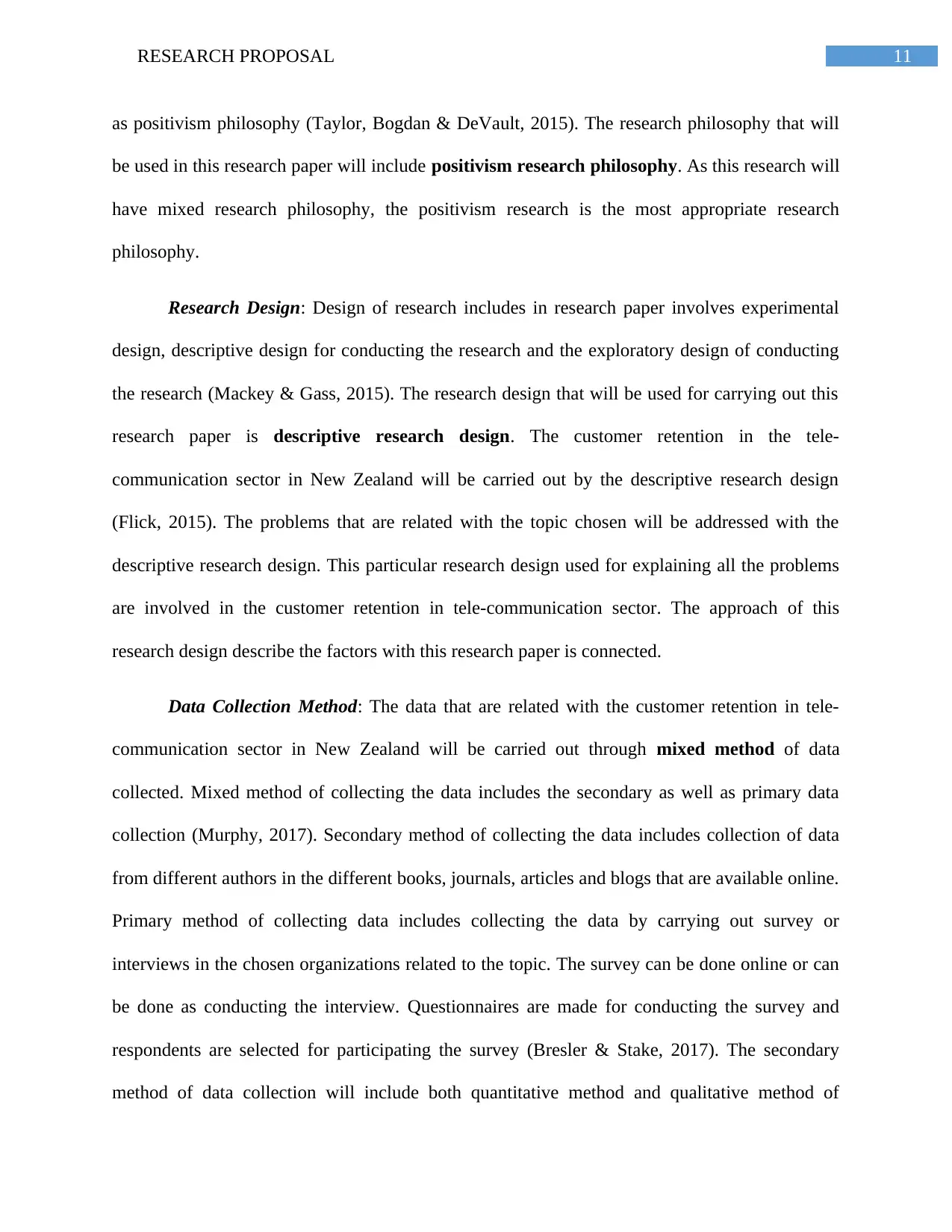
11RESEARCH PROPOSAL
as positivism philosophy (Taylor, Bogdan & DeVault, 2015). The research philosophy that will
be used in this research paper will include positivism research philosophy. As this research will
have mixed research philosophy, the positivism research is the most appropriate research
philosophy.
Research Design: Design of research includes in research paper involves experimental
design, descriptive design for conducting the research and the exploratory design of conducting
the research (Mackey & Gass, 2015). The research design that will be used for carrying out this
research paper is descriptive research design. The customer retention in the tele-
communication sector in New Zealand will be carried out by the descriptive research design
(Flick, 2015). The problems that are related with the topic chosen will be addressed with the
descriptive research design. This particular research design used for explaining all the problems
are involved in the customer retention in tele-communication sector. The approach of this
research design describe the factors with this research paper is connected.
Data Collection Method: The data that are related with the customer retention in tele-
communication sector in New Zealand will be carried out through mixed method of data
collected. Mixed method of collecting the data includes the secondary as well as primary data
collection (Murphy, 2017). Secondary method of collecting the data includes collection of data
from different authors in the different books, journals, articles and blogs that are available online.
Primary method of collecting data includes collecting the data by carrying out survey or
interviews in the chosen organizations related to the topic. The survey can be done online or can
be done as conducting the interview. Questionnaires are made for conducting the survey and
respondents are selected for participating the survey (Bresler & Stake, 2017). The secondary
method of data collection will include both quantitative method and qualitative method of
as positivism philosophy (Taylor, Bogdan & DeVault, 2015). The research philosophy that will
be used in this research paper will include positivism research philosophy. As this research will
have mixed research philosophy, the positivism research is the most appropriate research
philosophy.
Research Design: Design of research includes in research paper involves experimental
design, descriptive design for conducting the research and the exploratory design of conducting
the research (Mackey & Gass, 2015). The research design that will be used for carrying out this
research paper is descriptive research design. The customer retention in the tele-
communication sector in New Zealand will be carried out by the descriptive research design
(Flick, 2015). The problems that are related with the topic chosen will be addressed with the
descriptive research design. This particular research design used for explaining all the problems
are involved in the customer retention in tele-communication sector. The approach of this
research design describe the factors with this research paper is connected.
Data Collection Method: The data that are related with the customer retention in tele-
communication sector in New Zealand will be carried out through mixed method of data
collected. Mixed method of collecting the data includes the secondary as well as primary data
collection (Murphy, 2017). Secondary method of collecting the data includes collection of data
from different authors in the different books, journals, articles and blogs that are available online.
Primary method of collecting data includes collecting the data by carrying out survey or
interviews in the chosen organizations related to the topic. The survey can be done online or can
be done as conducting the interview. Questionnaires are made for conducting the survey and
respondents are selected for participating the survey (Bresler & Stake, 2017). The secondary
method of data collection will include both quantitative method and qualitative method of
⊘ This is a preview!⊘
Do you want full access?
Subscribe today to unlock all pages.

Trusted by 1+ million students worldwide
1 out of 26
Related Documents
Your All-in-One AI-Powered Toolkit for Academic Success.
+13062052269
info@desklib.com
Available 24*7 on WhatsApp / Email
![[object Object]](/_next/static/media/star-bottom.7253800d.svg)
Unlock your academic potential
Copyright © 2020–2025 A2Z Services. All Rights Reserved. Developed and managed by ZUCOL.




